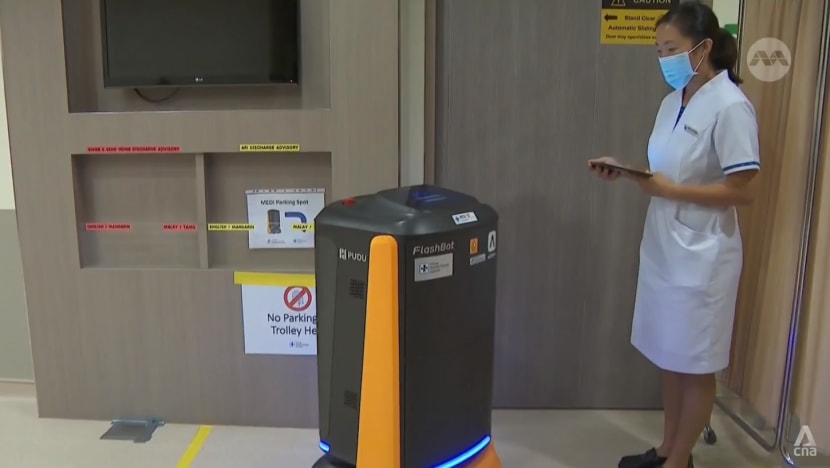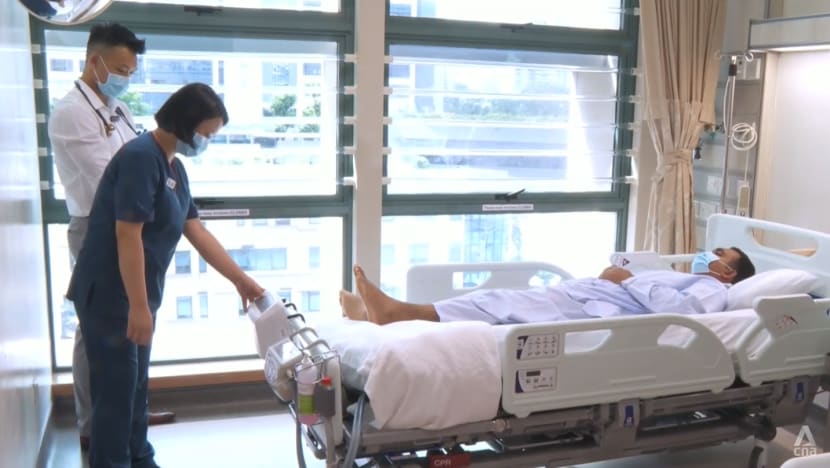Robots that deliver medication, voice-activated devices: Hospitals tap technology to improve patient care
One robot at Changi General Hospital can perform dedicated tasks, such as providing patients in the emergency department waiting area with items they need like a blanket.

One of Changi General Hospital’s robots makes 16 medication delivery rounds each day, saving precious time of up to two hours for the nurses there.
SINGAPORE: A robot that can deliver medication in the emergency department and beds that can turn patients at the push of a button. Hospitals here are leveraging technology to alleviate problems like high patient loads and a tight workforce.
One of Changi General Hospital’s (CGH) robots makes 16 medication delivery rounds each day, saving precious time of up to two hours for the nurses there.
With a lighter load, the nurses can have more time with their patients.
"It saves us a lot of time walking back and forth from my inpatient care areas to the pharmacy, and this saves at least a round trip of seven minutes,” said Ms Adora Cheong, assistant nurse clinician at the hospital’s emergency department.
She added that that time can then be spent with patients on tasks like wound dressing and attending to their basic care needs.
Another robot guides people to different areas of the emergency department, relieving nurses of the task of escorting patients in person, which typically takes one-and-a-half hours a day in total.
The consultation room is “quite a distance” away from the triaging area, said Ms Cheong. It speaks four languages - English, Mandarin, Malay and Tamil.
A third robot can perform dedicated tasks, such as providing patients in the waiting area with items they need like a blanket. The robot alone has reduced the workload of retrieving items by nearly half.
This means service staff can focus on other tasks like helping patients with payment or discharge queries.
The robotic trial is expected to end in August. CGH is looking to deploy the robots for more tasks or mobilise the machines elsewhere in the hospital.
SMART WARD AT TTSH
At Tan Tock Seng Hospital’s (TTSH) Smart Ward, several devices have been introduced to make healthcare more efficient.
One device allows nurses and doctors to update one another quickly hands-free, without the use of the phone.
With the completely voice-activated device, nurses can say the name of the doctor they are looking for, and the device will connect them.
“Traditionally, we have to pick up a phone, find the contact number of the doctors and then dial and connect with the doctors and wait for the doctors to arrive on site to the ward,” said Smart Ward lead and senior nurse manager Lim Mei Ling.
They can also use the device’s camera to scan items like medication or bandages for doctors to assess the situation and make a call on what to do next for a patient, saving time, Ms Lim added.
The device is one of 20 innovations that have been tested at the TTSH Smart Ward since 2022. Another new technology at the ward is a bed that turns bed-bound patients with the push of a button, reducing the need for labour-intensive work.
Such patients need to be turned every two hours to prevent pressure injuries caused by lying on one side for too long. The task typically requires nurses to use intensive physical strength and can sometimes cause them to get injured.
The new technology also prevents other patients from being disturbed.
“If we need nurses to do it, we will switch on the light in the middle of the night, draw the curtains. So I'm not only disturbing the patient but also the neighbouring patient,” said Ms Lim.
A patient monitoring system currently installed in all single-bed and isolation wards in TTSH will also inform nurses should one try to leave their bed.
It has reduced the rate of falls by 34 per cent and saved 67 per cent of manpower hours compared to the previous tracking system of using a mat.

CHALLENGES TO OVERCOME
“We do know that (with) the ageing population, patients are getting more and more complex. Staff are getting more and more overworked and (there are) more and more issues that we need to face. So with the use of technology and AI we are trying to use it to see where they can help us improve patient care,” said Smart Ward co-lead Dr Keefe Tan.
The hospital will scale 14 initiatives to other wards and rapidly test another 20 within the next two years. TTSH’s Ms Lim said that new technologies typically require time to adjust to.
“We have to understand why there is a need for change. And then we have to unlearn and relearn a new technology. So that may take some time,” she said, adding that nurses are resilient. At CGH, the hope is that the robots can lighten workloads, as hospitals here continue to see high patient volumes.
Currently, there is a waiting time of between five and eight hours at CGH's emergency department.
“We wanted to harness the use of robotics to find a more innovative solution to optimise our manpower, resources and also to streamline our processes in the ED (emergency department),” said senior nurse manager at CGH Emergency Department Elaine Leong.





















